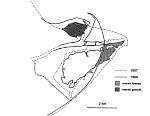Chapter
3: Man-induced interference in coastal
processes 3.1 Reduction in sediment supplies

| European Coasts - An Introductory Survey Chapter 3: Man-induced interference in coastal
processes 3.1 Reduction in sediment supplies |
|
 |
 |
 |
| Fig 57: The Atlantique, a suction hopper dredger with a floating pipeline doing its job | Fig 58: Erosion at the Ebro river mouth in Spain | Fig 59: Ebro river mouth, with high erosion rates |
Large quantities of sediment are constantly being moved within the coastal system, either by longshore or
cross-shore transport or by rivers which can add significant amounts of sediment to the coastal area. Interruption of natural sediment supplies, due to dredging or artificial structures, changes this coastal system.
Hence, erosion or accretion problems occur.
Art example of civil engineering work which interrupts the sediment supply is the building of a river barrier. The purpose of such a construction may be irrigation, power generation or flood control. As a result of the barrier, the river sediment is blocked. Siltation occurs in the basin upstream of the dam; erosion occurs downstream. The river delta, which has been shaped as the result of a delicate balance between the river sediment supply and the coastal currents, will be affected. Without additional measures, erosion of the river delta will result. This is illustrated in Fig. 58 and Fig. 59. The Ebro river delta has experienced significant reshaping with large stretches being eroded, since the construction of the Mequinenza-Ribarroja dam complex in the lower river course at the beginning of the' 60s.
previous page table of contents next page
| This page is from the book "European Coasts", produced in the framework of the Erasmus project under EC contract ICP 92-G-2013 and placed on the Internet in the framework of the PIANC-MarCom initiative on Education. |